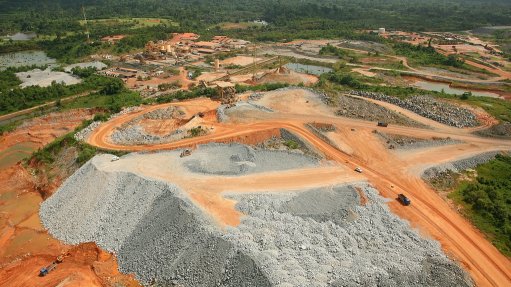
The Damang gold mine in Ghana
JOHANNESBURG (miningweekly.com) – The outcome of an independent study into Gold Fields’ Damang gold mine in Ghana will determine whether mine’s central pit is recapitalised, possibly at a level of $100-million, or its inherent value preserved until gold prices recover.
“We should be in a position to announce a decision early next year,” Gold Fields CEO Nick Holland told a media conference attended by Creamer Media’s Mining Weekly Online. (Also watch attached Creamer Media video).
The study will evaluate the technical and commercial merits of a push-back under and around Damang’s original pit, where mining ceased in 2013.
The company expects to have the necessary information before the end of the first quarter of 2016 to enable it to decide on the economic viability of accessing centrally located high-grade gold, which will require capital-intensive waste removal over a probable period of 12 to 18 months.
“What we found was that the higher grades were actually concentrated in the centre and consideration is now being given to having a smaller higher-grade project in the centre, which could extend the mine life by eight to ten years,” Holland revealed.
Should Damang’s sweet spot be found to have a grade of 1.8 g/t to 2 g/t, the leverage of the operation to its costs would be enormous.
“Damang is a high-grade, low volume mine. We need the grade because it doesn’t have huge volume,” Gold Fields CFO Paul Schmidt explained. (Also watch attached Creamer Media video).
In the last quarter, Damang yielded 1.2 g/t.
Alternatively, if the gold price proves inappropriate to allow Damang to recover capital investment and make a return on the investment, the operation is likely to be put on care and maintenance, involving a cessation of mining but ongoing plant operation and the retention of a nucleus of personnel engaged in geological modelling.
The plant has a capacity of 5.1-million tons of throughput a year.
“We’ve got a considerable volume of low-grade stockpiles that can be processed, so there wouldn’t be a complete standstill but it would be a downscaling from where we are,” said Holland.
The current Damang employment complement is made up of 1 000 Gold Fields employees and 1 000 contractors.
The Damang mine, located in the south-west of Ghana’s Western Region, has estimated reserves of 10-million ounces of gold.
Ghana does not offer the weaker currency respite of most other regions and is fully exposed to further declines in the dollar gold price.
Gold production from the company’s West African operations decreased by 2% to 174 000 oz in the third quarter of this year on lower production at Tarkwa, with costs falling to $962/oz.
The full mining lease underwent a prospectivity assessment in 2014 to identify and rank brownfield opportunities.
The mine exploits oxide and fresh hydrothermal mineralisation in addition to Witwatersrand style palaeoplacer mineralisation.
The hydrothermal mineralisation is located in Tarkwaian sediments and is the only deposit of its kind, located on the eastern side of the Ashanti Belt in southwest Ghana.
The Damang concession covers 27 174 ha. Without Damang, Gold Fields free cash flow margin would this year probably have been about 0.5% higher.
Gold Fields overall third-quarter earnings were $18-million, with operational cash flow of $75-million two-and-a-half times higher than the $30-million in the corresponding period last year.
This enabled Gold Fields to cut net debt by $50-million to $1 427-million and bring it to 1.41 times earnings before interest, taxes, depreciation and amortisation.
Higher production, weaker currencies and the lower oil price helped it to realise a free-cash-flow margin of 11% at a third-quarter gold price of $1 103/oz and saw its total all-in costs reduce to $961/oz on 557 000 oz produced from July 1 to September 30.
The Johannesburg- and New York-listed company’s only South African gold mine – South Deep, west of Johannesburg – delivered a much improved third quarter, with its gold production rising 42% to 54 900 oz (1 709 kg), driven by a 30% increase in tons milled and a 13% increase in underground yield.
South Deep’s raised game follows a strategic mine design change in the destress method, involving a conversion from low-profile 2.5 m vertical height to high-profile 5 m vertical height.
The transition to high-profile distress is expected to continue until the early part of 2017.
Outflow of cash from South Deep fell to R266-million and development increased 58% to 1 486 m.
Gold production at the Australian operations increased 6% to 249 000 oz with costs 9% down at A$1 173/oz and gold production at Cerro Corona in Peru fell 5% to 78 800 oz, with costs up 10% to $731/oz.
Full-year production is expected to be within 2% of previous guidance with costs guided at up to $1 055/oz.
Gold Fields told Mining Weekly Online that its current strategy was to develop its own assets and to avoid acquiring assets that needed development.
The company noted that gold-mining companies were struggling to replace the ounces they mined owing to greenfields exploration having been slashed and sustaining capital cutback.
This was poised to have an impact on production in as little as one year’s time.
Paradoxically, gold was thus becoming scarcer at a time when prices were declining down and companies were buying gold assets at high prices to protect future production capacity.
Holland estimated that there was probably another couple years of pain for the mining industry as a whole before there was a turn for the better.
In the meantime, investors would continue to buy gold to protect their wealth, as they had been doing for centuries.
If anything, investors were under exposed to gold given that, as percentage of global funds under management, total gold investment represented a negligible 1%.